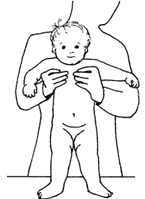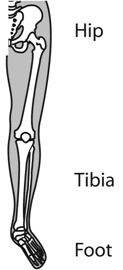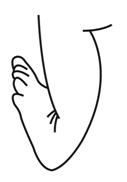 Toeing out is less common than toeing in, but is seen quite often. It is most common in young infants. The three primary causes of toeing out are:
Toeing out is less common than toeing in, but is seen quite often. It is most common in young infants. The three primary causes of toeing out are:
1. External rotation of the hip
2. External tibial torsion (twisting outward) in the leg
3. Calcaneovalgus in the foot
External Rotation of the Hip
 In this case the infant is born with external rotation of the entire leg, so that the foot is pointing outward. This condition is thought to be due to tightness in the hip muscles. It usually corrects as the child begins to walk, and after the age of one year the problem gradually disappears. Exercising the leg by rolling them inward may help. Special shoes and other devices are not necessary.
In this case the infant is born with external rotation of the entire leg, so that the foot is pointing outward. This condition is thought to be due to tightness in the hip muscles. It usually corrects as the child begins to walk, and after the age of one year the problem gradually disappears. Exercising the leg by rolling them inward may help. Special shoes and other devices are not necessary.
External Tibial Torsion in the Leg
With this condition the patient out toes because of an outward rotation in the tibia, the bone in the lower part of the leg. This is caused by the positioning of the infant’s legs before birth, while the infant is still in the uterus. External tibial torsion tends to improve spontaneously by 12 to 18 months of age. Special shoes or braces are not necessary.
Calcaneovalgus in the foot
 This common problem is evident at birth and may be very alarming to parents. The whole foot is turned upward and outward and may be touching the lower part of the shin. However, the deformity is not rigid. Gentle but firm pressure corrects the abnormal position and allows the foot to assume a more normal position, even if only momentarily. This condition usually completely corrects itself in six to nine months. Gentle stretching of the foot by the parent at home, with each diaper change, may improve the foot position. Special shoes or casting are not usually necessary.
This common problem is evident at birth and may be very alarming to parents. The whole foot is turned upward and outward and may be touching the lower part of the shin. However, the deformity is not rigid. Gentle but firm pressure corrects the abnormal position and allows the foot to assume a more normal position, even if only momentarily. This condition usually completely corrects itself in six to nine months. Gentle stretching of the foot by the parent at home, with each diaper change, may improve the foot position. Special shoes or casting are not usually necessary.
For more information, see our KidsHealth article.